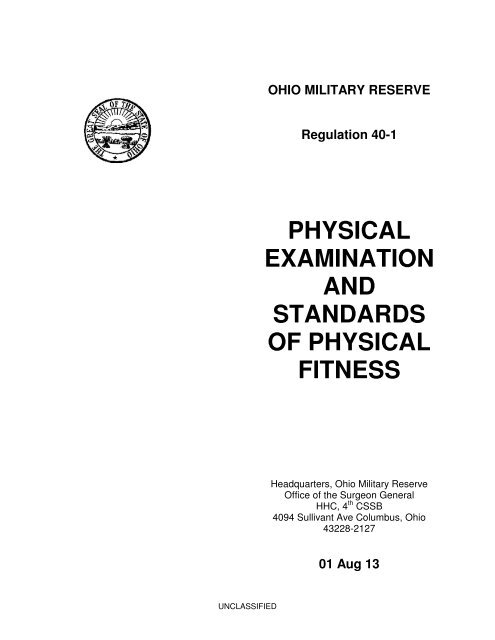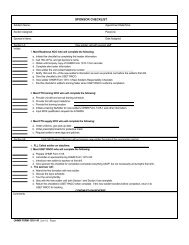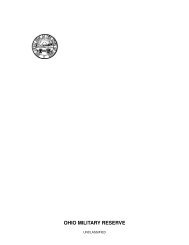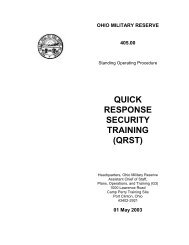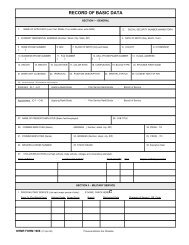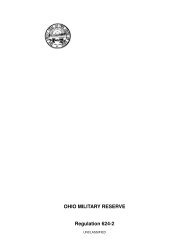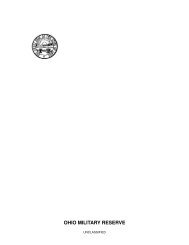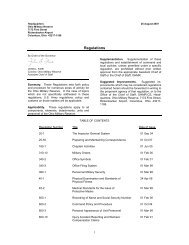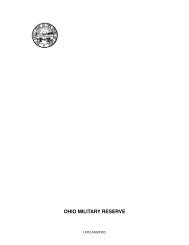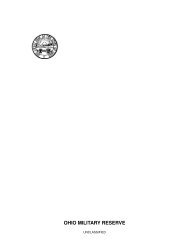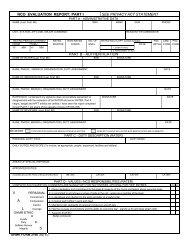physical examination and standards of physical fitness
physical examination and standards of physical fitness
physical examination and standards of physical fitness
- No tags were found...
You also want an ePaper? Increase the reach of your titles
YUMPU automatically turns print PDFs into web optimized ePapers that Google loves.
OHIO MILITARY RESERVERegulation 40-1PHYSICALEXAMINATIONANDSTANDARDSOF PHYSICALFITNESSHeadquarters, Ohio Military ReserveOffice <strong>of</strong> the Surgeon GeneralHHC, 4 th CSSB4094 Sullivant Ave Columbus, Ohio43228-212701 Aug 13UNCLASSIFIED
Summary <strong>of</strong> ChangesThe changes noted herein are only those changes <strong>of</strong> significance or which effect ongoing operations.Changes in terminology, organization or other routine matters are not reflected.OHMR Regulation 40-1, Physical Examination <strong>and</strong> St<strong>and</strong>ards <strong>of</strong> Physical Fitness, dated 01 Aug 13.ParagraphAllChangeRevision <strong>of</strong> Complete Regulation.i
HeadquartersOhio Military ReserveHHC, 4 th CSSB4094 Sullivant AveColumbus, Ohio 43228-212701 Aug 13OHMR Regulation 40-1Physical Examination <strong>and</strong> St<strong>and</strong>ards <strong>of</strong> Physical FitnessBy Order <strong>of</strong> the Governor:JOHN L. FAIRColonel, Ohio Military ReserveChief <strong>of</strong> StaffOfficial:JOSEPH F. KAISERLieutenant Colonel, Ohio Military ReserveSummary. This Regulation sets forth policy <strong>and</strong>guidance for <strong>physical</strong> <strong>examination</strong>s <strong>and</strong> <strong>fitness</strong>st<strong>and</strong>ards <strong>of</strong> the OHMR.Applicability. This regulation is applicable to allOHMR personnel including active.Supplementation. Supplementation <strong>of</strong> thisregulation <strong>and</strong> establishment <strong>of</strong> comm<strong>and</strong> <strong>and</strong>local policies are prohibited without prior writtenapproval from the Surgeon General, OHMR-SU.Suggested Improvements. Suggested improvementswhich may be considered for thisregulation should be forwarded in writing to theproponent agency <strong>of</strong> this regulation, the Office <strong>of</strong>the Surgeon General, OHMR-SU, 4094 SullivantAve, Columbus, Ohio 43228-2127.Supersedes. This regulation supersedes OHMR40-1, dated 01 February 2007.ContentsParagraphChapter 1IntroductionPurpose 1-1Objectives 1-2Medical Classification 1-3Waivers 1-4Chapter 2Medical Fitness St<strong>and</strong>ards for Appointment,Enlistment, <strong>and</strong> RetentionScope 2-1Applicability 2-2Ears 2-3Hearing 2-4Upper extremities 2-5Lower extremities 2-6Spine <strong>and</strong> sacroiliac joints 2-7Scapulae, clavicles, ribs 2-8Miscellaneous musculoskeletal 2-9Eyes 2-10Vision 2-11Heart 2-12Vascular System 2-13Cutaneous tissues 2-14ContentsParagraphSystemic disease <strong>and</strong> miscellane- 2-15ous conditionsGeneral <strong>and</strong> miscellaneous con- 2-16ditons <strong>and</strong> defectsChapter 3Physical Examination <strong>and</strong> Medical HistoryPhysical Examination 3-1Medical History 3-2Chapter 4Physical Fitness St<strong>and</strong>ardsEvaluation 4-1Failure to meet st<strong>and</strong>ards 4-2Weight to height 4-3Waist to hip ratio 4-4Physical <strong>fitness</strong> test 4-5Testing 4-6Waivers 4-7Appendix AWeight to Height TableAppendix BPhysical Fitness Tables
Appendix CForm 705, Physical Fitness Test RecordAppendix DOHMR Medical Waiver AgreementChapter 1Introduction1-1. Purpose. This regulation prescribespolicies, responsibilities, <strong>and</strong> procedures forthe use, preparation, <strong>and</strong> disposition <strong>of</strong>OHMR Form 88/93 (Medical Examination/MedicalHistory). It provides medical<strong>fitness</strong> st<strong>and</strong>ards to insure uniformity in themedical evaluation <strong>of</strong>:a. C<strong>and</strong>idates for military service orpersons in the military service in terms <strong>of</strong>medical conditions <strong>and</strong> <strong>physical</strong> defectswhich are causes for rejection or un<strong>fitness</strong>for military service.b. C<strong>and</strong>idates for, <strong>and</strong> persons in,certain enlisted military occupational specialties<strong>and</strong> <strong>of</strong>ficer duty assignments, interms <strong>of</strong> medical conditions <strong>and</strong> <strong>physical</strong>defects which are causes for rejection ormedical un<strong>fitness</strong> for those specialized duties.1-2. Objectives. The objectives <strong>of</strong> this regulationare as follows:a. Commission <strong>and</strong> enlist in theOhio Military Reserve individuals who are:1) Free <strong>of</strong> contagious or infectiousdiseases which would be likely to endangerthe health <strong>of</strong> other personnel.2) Free <strong>of</strong> medical conditions or<strong>physical</strong> defects which would require excessivetime lost from duty by reason <strong>of</strong> necessarytreatment or hospitalization or mostprobably result in separation from the serviceby reason <strong>of</strong> medical un<strong>fitness</strong>.3) Medically capable <strong>of</strong> satisfactorilycompleting required training.4) Medically adaptable to the militaryenvironment without the necessity <strong>of</strong>geographical area limitations.5) Medically capable <strong>of</strong> performingduties without aggravation <strong>of</strong> existingmedical conditions or <strong>physical</strong> defects.b. Provide for the timely separationfrom the Ohio Military Reserve those individualswhose continued performance <strong>of</strong>duty would compromise their health <strong>and</strong>well-being or prejudice the interests <strong>of</strong> theState <strong>of</strong> Ohio.c. Provide realistic procurement <strong>and</strong>retention <strong>of</strong> <strong>of</strong>ficers <strong>and</strong> enlisted by medical<strong>fitness</strong> criteria, while excluding fromconsideration those individuals with medicalconditions or <strong>physical</strong> defects which wouldcompromise their health <strong>and</strong> well-being orprejudice the interests <strong>of</strong> the State <strong>of</strong> Ohio.d. Effect the maximum utilization <strong>of</strong>physicians by procuring physicians who, althoughthey may have medical conditions or<strong>physical</strong> defects which would ordinarily because for rejection for original entry into themilitary service, may be expected to performappropriate military duties as physicians.e. Provide general administrativeguidelines for the conduct <strong>of</strong> military medical<strong>examination</strong>s <strong>and</strong> specific policy statementsregarding the scope <strong>of</strong> these <strong>examination</strong>s,the manner <strong>of</strong> recording findings, <strong>and</strong> the frequency<strong>and</strong> validity periods <strong>of</strong> such <strong>examination</strong>s1-3. Medical Classification. Individuals evaluatedunder the medical <strong>fitness</strong> st<strong>and</strong>ards containedin this regulation will be reported asindicated below:a. Medically acceptable. Medical examinerswill report as "medically acceptable"all individuals who meet the <strong>fitness</strong> st<strong>and</strong>ardsestablished for the particular purpose forwhich examined. No individuals will be acceptedon a provisional basis subject to thesuccessful treatment or correction <strong>of</strong> a disqualifyingcondition.b. Medically unacceptable. Medicalexaminers will report as "medically unacceptable"by reason <strong>of</strong> medical un<strong>fitness</strong> all individualswho possess any one or more <strong>of</strong> themedical or <strong>physical</strong> conditions listed in thisregulation as a cause for rejection for the specificpurpose for which examined, except asnoted in subparagraph c. Examinees reportedas medically unacceptable by reason <strong>of</strong> medicalun<strong>fitness</strong> will be rejected when the medical<strong>fitness</strong> st<strong>and</strong>ards in chapter 2 apply.c. Medically unacceptable prior administrativewaiver granted. Medical examinerswill report as "medically unacceptable prioradministrative waiver granted" all individualswho do not meet the medical <strong>fitness</strong> st<strong>and</strong>ards
for the particular purpose for which examinedafter a waiver has been previouslygranted <strong>and</strong> all the provisions <strong>of</strong> paragraph1-4c apply.1-4. Waivers.a. Medical <strong>fitness</strong> st<strong>and</strong>ards cannotbe waived by medical examiners or by theexaminee.b. Examinees initially reported asmedically unacceptable by reason <strong>of</strong> medicalun<strong>fitness</strong> when the medical <strong>fitness</strong> st<strong>and</strong>ardsin Chapter 2 apply, may request awaiver <strong>of</strong> the medical <strong>fitness</strong> st<strong>and</strong>ards.OHMR Form 22-3, Request for Waiver, withappropriate documentation attached, if applicable,will be submitted through staffchannels to the Deputy Chief <strong>of</strong> Staff, Personnel(G1). Waivers may be granted by theComm<strong>and</strong>ing General, OHMR, with appropriatepr<strong>of</strong>essional medical advice.c. Waivers <strong>of</strong> medical <strong>fitness</strong> st<strong>and</strong>ardswhich have been previously grantedapply automatically to subsequent medicalactions pertinent to the program or purposefor which granted without the necessity <strong>of</strong>confirmation or termination when:1) The duration <strong>of</strong> the waiver wasnot limited at the time it was granted, <strong>and</strong>2) the medical or <strong>physical</strong> conditionhas not interfered with the individual'ssuccessful performance <strong>of</strong> military duty, <strong>and</strong>3) the medical or <strong>physical</strong> conditionwaived was below retention medical<strong>fitness</strong> st<strong>and</strong>ards applicable to the particularprogram involved <strong>and</strong> the medical or <strong>physical</strong>condition has remained essentially unchanged,or4) the medical or <strong>physical</strong> conditionwaived was below procurement medical<strong>fitness</strong> st<strong>and</strong>ards applicable to the particularprogram or purpose involved <strong>and</strong> the medicalor <strong>physical</strong> condition, although worse, iswithin the retention medical <strong>fitness</strong> st<strong>and</strong>ardsprescribed for the purpose or programinvolved.Chapter 2Medical Fitness St<strong>and</strong>ards for Appointment,Enlistment <strong>and</strong> Retention2-1. Scope.This chapter sets forth the medical <strong>and</strong> <strong>physical</strong>conditions which are causes for rejectionfor military service in the Ohio Military Reserve.2-2. Applicability.These st<strong>and</strong>ards applya. to applicants for appointment as acommissioned <strong>of</strong>ficer in the Ohio Military Reserve;b. to applicants for enlistment in theOhio Military Reserve;c. to applicants for reenlistment in theOhio Military Reserve;d. to active <strong>of</strong>ficers <strong>and</strong> enlisted personsreferred for re<strong>examination</strong> by a medical<strong>of</strong>ficer or by comm<strong>and</strong>ers as subjects whose<strong>physical</strong> <strong>fitness</strong> may have fallen below thesest<strong>and</strong>ards;e. to periodic <strong>physical</strong> <strong>examination</strong>sas determined by Headquarters, 4 th CSSB,Ohio Military Reserve.2-3. Ears.a. Auditory canal.1) Atresia or severe stenosis <strong>of</strong> theexternal auditory canal, if bilateral.2) Protruding tumors <strong>of</strong> the externalauditory canal except mild exostoses.3) Severe purulent external otitis,acute or chronic.b. Auricle. Agenesis, severe; or severetraumatic deformity, unilateral or bilateral.c. Mastoids.1) Mastoiditis, purulent; acute orchronic.2) Residual or mastoid operationwith marked external deformity which precludesor interferes with the wearing <strong>of</strong> a gasmask or helmet.3) Mastoid fistula.d. Meniere's syndrome, severe.e. Middle ear.1) Acute or chronic supporativeotitis media. Individuals with a recent history <strong>of</strong>acute supporative otitis media will not be acceptedunless the condition is healed <strong>and</strong> asufficient interval <strong>of</strong> time subsequent to treatmenthas elapsed to insure that the disease isin fact not chronic.2) Acute or chronic serous otitismedia.3) Presence <strong>of</strong> attic perforation inwhich presence <strong>of</strong> cholesteatoma is suspected.
4) Repeated attacks <strong>of</strong> catarrhalotitis media; intact grayish, thickeneddrum(s).f. Tympanic membrane1) Any perforation <strong>of</strong> the tympanicmembraneg. Any defects <strong>of</strong> the ear which obviouslypreclude satisfactory performance <strong>of</strong>military duty or which require frequent <strong>and</strong>prolonged treatment.2-4. Hearing. Hearing acuity level by whisperedor spoken voice test hearing less than8/15 bilateral; or less than 15/15 in one ear<strong>and</strong> less than 8/15 in one ear.2-5. Upper extremities.a. Limitation <strong>of</strong> motion - an individualwill be unacceptable if the joint ranges <strong>of</strong>motion are less than:1) Shoulder.a) Forward elevation to 90degrees.b) Abduction to 90 degrees.2) Elbow.a) Flexion to 100 degrees.b) Extension to 15 degrees.3) Wrist: Total range <strong>of</strong> 15 degrees(extension plus flexion).4) H<strong>and</strong>.a) Pronation to the first quarter <strong>of</strong>the normal arc.b) Supination to the first quarter <strong>of</strong>the normal arc.5) Fingers.a) Inability to clench fingers.b) With remaining fingers,inability to pick up a pin or needle <strong>and</strong> tograsp an object.b. H<strong>and</strong> <strong>and</strong> fingers: scars <strong>and</strong> deformities<strong>of</strong> the fingers <strong>and</strong>/or h<strong>and</strong> which1) impair circulation,2) are symptomatic,3) draw attention away from amilitary appearance4) or impair normal function tosuch a degree as to interfere with the satisfactoryperformance <strong>of</strong> dutyc. Wrist, forearm, elbow, arm, <strong>and</strong>shoulder: healed disease or injury <strong>of</strong> abovewith residual weakness <strong>of</strong> or symptoms <strong>of</strong>such a degree as to preclude satisfactoryperformance <strong>of</strong> duty.2-6. Lower extremities.a. Limitation <strong>of</strong> motion: an individualwill be considered unacceptable if the jointranges <strong>of</strong> motion are less than:1) Hip.a) Flexion to 90 degrees.b) Extension to 10 degrees (beyond 0).2) Knee.a) Full extension.b) Flexion to 90 degrees.3) Ankle.a) Dorsiflexion to 10 degrees.b) Plantar flexion to 10 degrees.4) Toes: Stiffness which interfereswith walking, marching, running, or jumping.b. Foot <strong>and</strong> ankle. Abscess, scar ordeformity which impairs normal function suchthat running <strong>and</strong> jumping are precluded orwhich interferes with the satisfactory performance<strong>of</strong> military duty.c. Leg, knee, thigh, <strong>and</strong> hip.1) Dislocated semilunar cartilage,loose or foreign bodies within the knee joint, orhistory <strong>of</strong> surgical correction <strong>of</strong> same ifa) within the preceding six (6)months.b) six months or more haveelapsed since operation without recurrence<strong>and</strong>(1) there is instability <strong>of</strong> theknee ligaments in lateral or anteroposteriordirections in comparison with the normal kneeor abnormalities noted on x-ray or,(2) there is significant atrophyor weakness <strong>of</strong> the thigh musculature incomparison with the normal side or,(3) there is not acceptableactive motion in flexionor extension, or(4) there are other symptoms<strong>of</strong> internal derangement.2) Authentic history or <strong>physical</strong>findings <strong>of</strong> an unstable or internally derangedjoint causing disabling pain or seriously limitingfunction. individuals with verified episodes<strong>of</strong> buckling or locking <strong>of</strong> the knee who havenot undergone satisfactory surgical correctionor if, subsequent to surgery, there is evidence<strong>of</strong> more than mild instability <strong>of</strong> the knee ligamentsin lateral <strong>and</strong> anteroposterior directionsin comparison with the normal knee, weaknessor atrophy <strong>of</strong> the thigh musculature incomparison with the normal side or, if the individualrequires medical treatment <strong>of</strong> sufficient
frequency to interfere with the performance<strong>of</strong> military duty.d. General.1) Deformities <strong>of</strong> one or bothlower extremities which have interfered withfunction to such a degree as to prevent theindividual from following a <strong>physical</strong>ly activevocation in civilian life or which would interferewith the satisfactory completion <strong>of</strong> prescribedtraining <strong>and</strong> performance <strong>of</strong> militaryduty.2) Diseases or deformities <strong>of</strong> thehip, knee, or ankle joint which interfere withwalking, running or weight bearing.3) Pain in the lower back or legwhich is intractable <strong>and</strong> disabling to the degree<strong>of</strong> interfering with walking, running orweight bearing.4) Shortening <strong>of</strong> a lower extremityresulting in any limp <strong>of</strong> noticeable degree.2-6. Spine <strong>and</strong> sacroiliac joints.a. Bone or joint lesions such as1) arthritis,2) complaint or injuring <strong>of</strong>the spine or sacroiliac joints,3) deviation or curvature <strong>of</strong> thespine or pelvic bones,4) protruded intervertebral disc,5) spondylosis or,6) spondylolisthesis which aresufficiently symptomatic or defective to interferewith the satisfactory performance <strong>of</strong>military duty.2-8. Scapulae, clavicle, ribs.a. Fractures, osteomyelitis, orprominent scapulae which may interfere withfunctions or with wearing the military uniform.2-9. Miscellaneous musculoskeletal. Thecauses for rejection are:a. Arthritis.1) Active or subacute arthritis,including Marie-Strumpell type.2) Chronic osteoarthritis or traumaticarthritis <strong>of</strong> isolated joints <strong>of</strong> more thanminimal degree, which has interfered withthe following <strong>of</strong> a <strong>physical</strong>ly active vocationin civilian life or which precludes the satisfactoryperformance <strong>of</strong> military duty.3) Documented clinical history <strong>of</strong>rheumatoid arthritis.4) Traumatic arthritis <strong>of</strong> a majorjoint <strong>of</strong> more than minimal degree.b. Disease <strong>of</strong> any bone or joint,healed, with resulting deformity or rigidity thatfunction is impaired to such a degree that itwill interfere with military service.c. Dislocation. Old unreduced; substantiatedhistory <strong>of</strong> recurrent dislocations <strong>of</strong>major joints; instability <strong>of</strong> major joint, symptomatic<strong>and</strong> more than mild; or if, subsequent tosurgery. there is evidence <strong>of</strong> more than mildinstability in comparison with the normal joint,weakness or atrophy in comparison with thenormal side, or if the individual requires medicaltreatment <strong>of</strong> sufficient frequency to interferewith the performance <strong>of</strong> military duty.d. Fractures.1) Malunited fractures that interferesignificantly with function.2) Ununited fractures.3) Any old or recent fracture inwhich a plate, pin, or screws were used forfixation <strong>and</strong> left in place <strong>and</strong> which may besubject to easy trauma, i.e. as a plate tibia,etc.e. Injury <strong>of</strong> a bone or joint within thepreceding six (6) weeks, without fracture ordislocation, <strong>of</strong> more than a minor nature.f. Muscular paralysis, contracture oratrophy, if progressive or <strong>of</strong> sufficient degreeto interfere with military service.g. Myotonia congenita. Confirmed, ifsufficient to interfere with military service.h. Osteomyelitis, active or recurrent,<strong>of</strong> any bone or substantiated history <strong>of</strong> osteomyelitis<strong>of</strong> any <strong>of</strong> the long bones unless successfullytreated two (2) or more years previouslywithout subsequent recurrence or disqualifyingsequelae as demonstrated by bothclinical <strong>and</strong> x-ray evidence.i. Osteoporosis, if sufficient to interferewith military service.j . Scars, extensive, deep, adherent,<strong>of</strong> the skin <strong>and</strong> s<strong>of</strong>t tissues or neuromas <strong>of</strong> anextremity which are painful, which interferewith muscular movements, which preclude thewearing <strong>of</strong> military equipment, or that show atendency to breakdown.k. Chondromalacia, manifested beverified history <strong>of</strong> joint effusion, interferencewith function, or residuals from surgery.2-10. Eyes. Any abnormality or dysfunction <strong>of</strong>lid, conjunctiva, cornea, uveal track, retina,
optic nerve, lens, ocular mobility <strong>and</strong> motility,<strong>of</strong> an existing eye such as to be contagiousor threaten continuity <strong>of</strong> vision or impairment<strong>of</strong> visual function.2-11. Vision.a. distant visual acuity <strong>of</strong> any degreewhich does not correct to at least one<strong>of</strong> the following:1) 20/40 in one eye <strong>and</strong> 20/70 inthe other eye.2) 20/30 in one eye <strong>and</strong> 20/100in the other eye.3) 20/20 in one eye <strong>and</strong> 20/400in the other eye.4) 20/20 in one eye, in the absence<strong>of</strong> the other eye.2-12. Heart.a. All organic diseases <strong>of</strong> the heart,coronary artery disease, myocardial infarction,electrocardiographic evidence <strong>of</strong> majorarrythmias, hypertrophy or dilation <strong>of</strong> theheart, myocardial insufficiency, paroxysmaltachycardia, or persistent tachycardia, whichis sufficient to interfere with military duty.2-13. Vascular system.a. Congenital or acquired lesions <strong>of</strong>the aorta or major vessels, hypertension,marked circulatory instability, peripheralvascular disease, thrombophlebitis, varicoseveins, or varicose ulcer, sufficient to interferewith the satisfactory performance <strong>of</strong>military duty.b. Miscellaneous cardiovascularabnormalities such as aneurysm <strong>of</strong> the heartor major blood vessels, congenital or acquired,history <strong>and</strong> evidence <strong>of</strong> a major congenitalabnormality <strong>of</strong> the heart or majorvessels, or substantiated history <strong>of</strong> rheumaticfever or chorea, sufficient to interferewith the satisfactory performance <strong>of</strong> militaryduty.2-14. Cutaneous tissues.a. Any communicable skin disorder.b. Any chronic skin disorder <strong>of</strong> adegree or nature which requires frequentoutpatient treatment or hospitalization, thatinterferes with satisfactory performance <strong>of</strong>military duty, or so disfiguring as to detractfrom a military appearance.c. Tattoos on any part <strong>of</strong> the bodywhich in the opinion <strong>of</strong> the examiner are obsceneor so extensive on exposed areas as tobe considered unsightly or grossly detractfrom a military appearance.2-15. Systemic disease.a. Any systemic disease such asdermatomyositis, lupus erythematosus, progressivesystemic sclerosis, Reiter's disease,sarcoidosis, diffuse scleroderma, or activetuberculosis in any form or location, any <strong>of</strong>which are sufficiently manifest as to interferewith satisfactory performance <strong>of</strong> military duty.2-16. General <strong>and</strong> miscellaneous conditions<strong>and</strong> defects.a. Miscellaneous abnormalities suchas allergic rhinitis, moderate to severe, allergicdermatoses, severs; bronchial asthma, moderateto severe; uncontrolled diabetes mellitus;any acute or chronic communicable disease,any malignant tumor, any benign tumorwhich may interfere with the satisfactory performance<strong>of</strong> military duty.b. Insufficient <strong>physical</strong> capacity orstamina to perform sustained effort for recurrentmoderate periods in the satisfactory performance<strong>of</strong> military duty.Chapter 3Medical History <strong>and</strong> Physical Examination3-1. Medical History. An examinee may completethe medical history portion <strong>of</strong> OHMRForm 93 himself to the degree that he is ablein advance <strong>of</strong> the medical <strong>examination</strong>. Thehistory should be reviewed with the examinerfor completeness <strong>and</strong> correctness <strong>of</strong> medicaldescriptions.3-2. Physical Examination.a. A <strong>physical</strong> <strong>examination</strong> for enlistment,appointment or determination <strong>of</strong> statusmay be conducted by any licensed physician,registered nurse or, in some cases, a militarymedical specialist designated by the OHMRSurgeon General. Except when conducted bymilitary medical personnel at the direction <strong>of</strong>the OHMR Surgeon General, any costs associatedwith the <strong>examination</strong> will be borne bythe examinee.
. The examiner will use an OHMRForm 88, Medical Examination, as a guidefor conducting the <strong>examination</strong> <strong>and</strong> will recordthe findings thereon. The form must besigned by the examiner.c. A <strong>physical</strong> <strong>examination</strong> completedby a physician for some other purpose,<strong>and</strong> not more than three months priorto the date <strong>of</strong> enlistment or appointment,may be submitted by the examinee in lieu <strong>of</strong>being examined again. It will be securelyattached (stapled) to the back <strong>of</strong> the individual'sOHMR Form 88 <strong>and</strong> a notation madeon the medical <strong>examination</strong> section <strong>of</strong> theform.Chapter 4Height, Weight, <strong>and</strong> Physical Fitness St<strong>and</strong>ards4-1. Evaluation.a. All persons enlisting or applyingfor appointment must meet these st<strong>and</strong>ards.b. All soldiers will be evaluated annuallyin conjunction with their annual EERor OER.c. All soldiers will be evaluatedwhen being considered for promotion.4-2. Failure to meet st<strong>and</strong>ards.a. Persons seeking enlistment orappointment who do not meet thest<strong>and</strong>ards will be disqualified. Soldiersapplying for a resident pr<strong>of</strong>essionaldevelopment course or for promotion whodo not meet the st<strong>and</strong>ards will not beconsidered. A waiver may be granted bythe Comm<strong>and</strong>ing General, or his designee,under the following circumstances:1. Upon a review <strong>of</strong> theresults <strong>of</strong> a medical <strong>examination</strong>, if itdetermined that a medical condition iscausing the overweight condition, a waivermay be granted if it is determined that theapplicant/enlistee can perform militaryservice without restriction, or2. Upon review <strong>of</strong> theresults <strong>of</strong> a medical <strong>examination</strong>, if it isdetermined that the applicant/enlistee doesnot have a medical condition, but canperform military service without restriction,the applicant may be granted a waiver if heor she agrees to participate in a prescribedweight management program, or3. A waiver may be granted ifthe enlistee/applicant agrees to submit to,<strong>and</strong> successfully passes, an OHMR PhysicalFitness Test on a yearly basis.b. Failure to meet any <strong>of</strong> the st<strong>and</strong>ardsat any other time an evaluation is requiredwill initiate a progressive remedial action:1. Upon the first incident <strong>of</strong> failure,the soldier will be counseled <strong>and</strong> given threemonths to show significant improvement towardthe required goal.2. If significant progress has beenmade but the required goal was not achievedwithin the first three months, the soldier will becounseled <strong>and</strong> given an additional threemonths to improve his scores. During thattime, the soldier is limited to wearing the classC uniform <strong>and</strong> restricted from participating inactivities which require class A or B uniform.3. If, following the six months <strong>of</strong> remedialactions described above, the soldierhas not achieved the required st<strong>and</strong>ards, thesoldier will be involuntarily separated.4-3. Weight to Heighta. See Appendix A.4-4. Waist to Hip Ratioa. Recent research <strong>and</strong> global studieshave indicated that Waist to Hip ratio is abetter predictor <strong>of</strong> the risk <strong>of</strong> heart attack <strong>and</strong>general health than body-mass index, thecurrent st<strong>and</strong>ard.b. The st<strong>and</strong>ard ratio is less than 0.95for male soldiers <strong>and</strong> less than 0.80 for femalesoldiers. If the ratio exceeds these st<strong>and</strong>ards,the soldier should be counseled that this is anunhealthy weight distribution <strong>and</strong> should beadvised to enter a medically supervised weightmanagement program.c. Determine the waist to hip ratio byobtaining the measurements as shown below<strong>and</strong> working the calculation as described.1. Measure the waist at the widestpoint (generally at the navel) using a tapemeasure.2. Measure the hips at the widestpoint (generally at the point <strong>of</strong> the buttocks)using a tape measure.3. Divide the waist measurement bythe hip measurement. The resultant sum is thewaist to hip ratio.
4. The waist to hip ratio will beused over the weight to height measurementto determine if a soldier meets st<strong>and</strong>ards.4-5. Physical Fitness Test. See Appendix B.4-6. Testing.a. All <strong>fitness</strong> testing is voluntary <strong>and</strong>done at the individual’s sole discretion <strong>and</strong>responsibility; no soldier or applicant can beordered to complete the testing requirements.However, by electing to not completethe testing, the individual voluntarilydisqualifies <strong>and</strong> makes himself ineligible forthose activities or actions which require successfulcompletion <strong>of</strong> a <strong>physical</strong> <strong>fitness</strong> test.b. Any person designated by thetesting unit’s comm<strong>and</strong>er may conduct thetesting. However, when conducting thewaist to hip ratio measuring, only femalesmay measure females.c. The OIC, NCOIC, or medicalpersonnel have the authority to restrict anymember from participating in <strong>physical</strong> <strong>fitness</strong>testing. Testing will be conducted in PTclothes, or at the soldier’s option, Class Cuniform without the blouse <strong>and</strong> with runningshoes in lieu <strong>of</strong> boots.d. All elements <strong>of</strong> the <strong>fitness</strong> testmust be completed in a single testing session;the individual may not do part <strong>of</strong> thetest one day <strong>and</strong> part the next. There is nolimit on the number <strong>of</strong> times an individualmay attempt any or all <strong>of</strong> the components <strong>of</strong>the test, so long as it is done the same day.The OIC or NCOIC <strong>of</strong> the testing session willdetermine the start <strong>and</strong> finish <strong>of</strong> the session.e. Individuals may rest flat on thefloor in the exercise position between sit-ups<strong>and</strong> pushups. The resting time counts aspart <strong>of</strong> the total elapsed time.f. Form 705, Physical Fitness TestRecord, (see Appendix C) will be used torecord the results <strong>of</strong> a soldier’s <strong>physical</strong><strong>fitness</strong> test. The form may be completed byany NCO or <strong>of</strong>ficer assigned to conduct <strong>and</strong>validate testing.g. The individual conducting the testwill fill in the test results in pen as theyoccur. Result will be compared toRegulation 40-1, Appendixes A <strong>and</strong> B, todetermine requirements <strong>and</strong> GO/ NO GOstatus. The appropriate box will be checked.The form will then be signed by the soliderbeing tested <strong>and</strong> the testing/validation NCOICor OIC.h. The test record will be filed in thesoldier’s local Miltary Personnel RecordsJacket (MPRJ) <strong>and</strong> a copy forwarded toDCSPER, OHMR for inclusion in the soldier’scentralized MPRJ. Additional copies maydistributed as needed (example: withpromotion recommendation or schoolapplication).4-7. Waiversa. Physical <strong>fitness</strong> st<strong>and</strong>ards cannotbe waived by examiners or by the examinee.b. Examinees initially reported as<strong>physical</strong>ly unacceptable by reason <strong>of</strong> <strong>physical</strong>un<strong>fitness</strong> based on the <strong>physical</strong> <strong>fitness</strong> st<strong>and</strong>ardsin this chapter, may request a waiver <strong>of</strong>the <strong>physical</strong> <strong>fitness</strong> st<strong>and</strong>ards. OHMR Form22-5, OHMR Medical Waiver Agreement, withappropriate documentation attached, will besubmitted through staff channels to the DeputyChief <strong>of</strong> Staff, Personnel (G1). Waivers maybe granted by the Comm<strong>and</strong>ing General,OHMR, with appropriate pr<strong>of</strong>essional medicaladvice.c. Physical <strong>fitness</strong> waivers will not begranted for simply being chronically overweight,out <strong>of</strong> shape, or too old. There mustbe a documented medical basis <strong>of</strong> <strong>physical</strong>impediment or impairment which precludesthe application <strong>of</strong> one or more <strong>of</strong> the st<strong>and</strong>ards<strong>of</strong> this chapter but which does not impairthe individual’s ability to perform militaryduty. In all cases <strong>of</strong> waiver, an alternativemeasure, or measures, <strong>of</strong> <strong>physical</strong> <strong>fitness</strong>testing will be required.c. Waivers <strong>of</strong> <strong>physical</strong> <strong>fitness</strong> st<strong>and</strong>ardswhich have been previously grantedapply automatically to subsequent medicalactions pertinent to the program or purpose forwhich granted without the necessity <strong>of</strong> confirmationor termination when:1) the duration <strong>of</strong> the waiver wasnot limited at the time it was granted, <strong>and</strong>2) the medical or <strong>physical</strong> conditionhas not interfered with the individual's successfulperformance <strong>of</strong> military duty, <strong>and</strong>3) the medical or <strong>physical</strong> conditionwaived was below retention medical <strong>fitness</strong>st<strong>and</strong>ards applicable to the particular program
involved <strong>and</strong> the medical or <strong>physical</strong> conditionhas remained essentially unchanged, or4) the medical or <strong>physical</strong> conditionwaived was below procurement medical<strong>fitness</strong> st<strong>and</strong>ards applicable to the particularprogram or purpose involved <strong>and</strong> the medicalor <strong>physical</strong> condition, although worse, iswithin the retention medical <strong>fitness</strong> st<strong>and</strong>ardsprescribed for the purpose or programinvolved.
APPENDIX A (Weight to Height Table) to Regulation 40-1 (Physical Examination <strong>and</strong> St<strong>and</strong>ards <strong>of</strong> Physical Fitness)Weight to Height Table1. Height is measured in stocking feet without shoes or boots, st<strong>and</strong>ing on a flat surface with the chinparallel to the floor. The body should be straight but not rigid, similar to the position <strong>of</strong> attention. Themeasurement will be rounded as follows:a. If the fraction is less than ½ inch, round down to the next whole number.b. If the fraction is more than ½ inch, round up to the next whole number.2. Weight is measured <strong>and</strong> recorded to the nearest pound following these guidelines:a. If the fraction is less than ½ pound, round down to the next whole number.b. If the fraction is more than ½ pound, round up to the next whole number.3. This chart is designed for weight measurements taken in a st<strong>and</strong>ard PT uniform (gym shorts <strong>and</strong> T-shirt; without shoes). Alternatively, measurements may be taken in a st<strong>and</strong>ard Class C uniform (BDU)consisting <strong>of</strong> blouse, trousers, belt, undershirt, underwear, <strong>and</strong> socks without boots. In this case, subtract4½ pounds from the measured weight to calculate the soldier’s equivalent weight.4. For soldiers over 80 inches, add 6 pounds per inch for males <strong>and</strong> 5 pounds per inch for females to calculatetable weights.Height Male Female(ininches) Age Age17-2021-2728-39 40+17-2021-2728-39 40+58 x x x x 141 144 148 15259 x x x x 145 145 152 15760 167 171 174 177 149 153 157 16161 171 175 180 182 153 158 161 16562 177 180 184 187 189 163 167 17263 181 185 190 193 163 168 172 17764 187 191 195 198 198 172 177 18165 192 196 201 203 172 177 181 18566 198 201 206 209 177 182 187 19167 203 208 209 213 181 185 191 19668 209 213 219 221 187 191 196 20269 214 219 224 229 191 195 201 20670 220 225 230 233 196 201 206 21271 225 230 235 239 201 205 211 21672 231 236 242 245 205 211 216 22373 240 242 248 251 211 216 222 22974 246 249 254 258 218 223 230 23575 249 255 261 264 223 229 235 24276 255 261 268 271 230 235 242 24977 262 268 274 278 234 241 248 25478 268 274 281 284 240 246 253 26079 274 281 288 291 245 252 259 26680 280 286 294 298 251 258 264 272A-1
APPENDIX B (Physical Fitness Tables) to Regulation 40-1 (Physical Examination <strong>and</strong> St<strong>and</strong>ards <strong>of</strong> PhysicalFitness)Physical Fitness Tables1. The OIC, NCOIC, or medical personnel have the authority to restrict any member fromparticipating in <strong>physical</strong> <strong>fitness</strong> testing.2. Physical Fitness testing will be conducted in PT clothes, or at the soldier’s option, Class C uniformwithout the blouse <strong>and</strong> with running shoes in lieu <strong>of</strong> boots.Situps - 2 minutesAge 17-21 22-26 27-31 32-36 37-41 42-46 47-51 52-56 57-61 62+Male 21 19 17 15 13 12 11 10 9 8Female20 18 16 14 12 11 10 9 8 7Pushups - 2 minutesAge 17-21 22-26 27-31 32-36 37-41 42-46 47-51 52-56 57-61 62+Male 17 16 15 13 13 10 9 6 5 4Female7 6 6 6 5 5 4 4 3 21 Mile - timedAge 17-21 22-26 27-31 32-36 37-41 42-46 47-51 52-56 57-61 62+Male 11:13 11:42 12:11 12:43 13:09 13:37 13:52 14:00 14:35 14:50Female13:23 13:52 14:50 16:02 16:32 17:00 17:15 17:30 17:51 18:05B-1
APPENDIX C (Physical Fitness Test Record) to Regulation 40-1 (Physical Examination <strong>and</strong> St<strong>and</strong>ards <strong>of</strong>Physical Fitness)1. Form 705, Physical Fitness Test Record, will be used to record the results <strong>of</strong> a soldier’s <strong>physical</strong><strong>fitness</strong> test. The form may be completed by any NCO or <strong>of</strong>ficer assigned to conduct <strong>and</strong> validatetesting.2. The individual conducting the test will fill in the test results in pen as they occur. Result will becompared to Regulation 40-1 to determine requirements <strong>and</strong> GO/ NO GO status. The appropriatebox will be checked. The form will then be signed by the solider being tested <strong>and</strong> thetesting/validation NCOIC or OIC.3. The test record will be filed in the soldier’s local MPRJ <strong>and</strong> a copy forwarded to DCSPER, OHMRfor inclusion in the soldier’s centralized MPRJ. Additional copies may distributed as needed(example: with promotion recommendation or school application).C-1
APPENDIX D (OHMR Medical Waiver Agreement)OHIO MILITARY RESERVEHeadquarters <strong>and</strong> Headquarters Company, 4 th CSSBHaubrich Armory4094 Sullivant Ave.Columbus, OH 43228REPLY TOATTENTION OFOHMR Medical Waiver AgreementDate:___________________, 20_________In consideration <strong>of</strong> active membership in the Ohio Military Reserve, I ____________________________do hereby agree to decrease my body weight appropriately in compliance with a st<strong>and</strong>ard Body MassIndex ratio for my height.I agree that my blood pressure <strong>and</strong> cardiac status is to be monitored <strong>and</strong> controlled by my personal physicianwith regular reports sent to the Medical Battalion so compliance may be ascertained <strong>and</strong>verified.I further agree that I will provide a minimum <strong>of</strong> quarterly reports (every three months) to the Medical Battalionuntil compliance is met fully or until released from this requirement by the MedicalBattalion.I declare that have read <strong>and</strong> underst<strong>and</strong> this agreement <strong>and</strong> agree to abide by its terms <strong>and</strong> conditions. Iagree that if I do not follow the terms set out above I may, at the discretion <strong>of</strong> the Ohio Military Reserve,be discharged under honorable conditions from active service due to medical reasons.________________________________________________Soldier Signature________________________________________________Witnessing OfficerOHMR Form 22-5 (Aug 13)
APPENDIX D (OHMR Medical Waiver Agreement)OHMR Form 22-5 (Aug 13)


